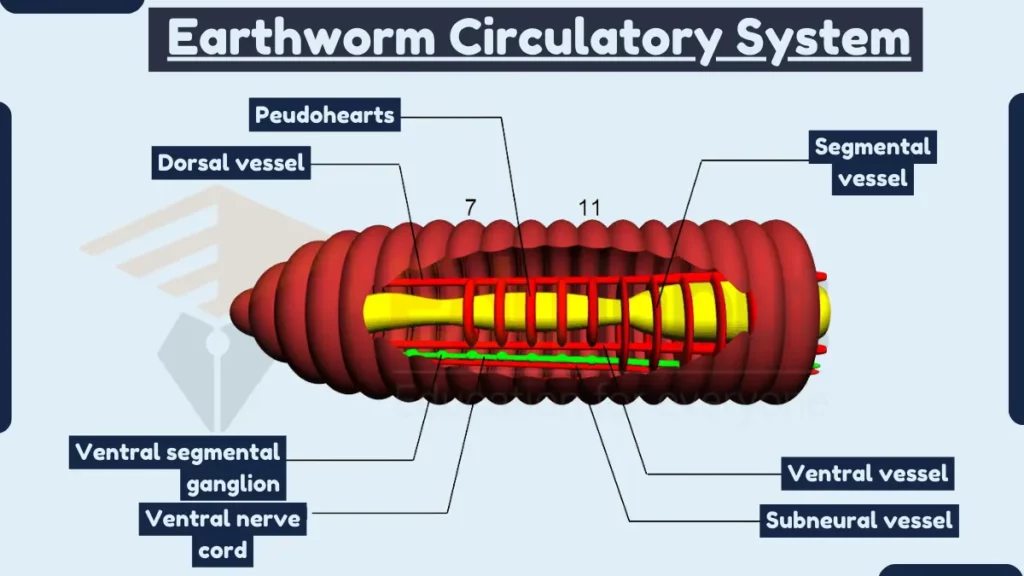Circulatory System of Earthworm-How Does it Work?
Earthworms have a closed circulatory system, which means that their blood is enclosed within blood vessels. The circulatory system is responsible for transporting oxygen and nutrients to all of the body’s cells and removing waste products.
Earthworms do not have a true heart in the same way that humans and other vertebrates do. Their hearts are actually modified aortic arches, which are blood vessels that connect the dorsal and ventral blood vessels.

Structure of Earthworm Circulatory System
Circulatory system of earthworm consists of following organs:
1. Hearts
Earthworms have five pairs of hearts, located in the 7th, 9th, 12th, and 13th segments. These hearts are neurogenic, meaning that their beating is controlled by nerve cells. The hearts are contractile and surround the alimentary canal.
The hearts can be divided into two types:
- Lateral hearts: There is one pair of lateral hearts in the 7th and one pair in the 9th segment. Each lateral heart has four pairs of valves that allow blood to flow downwards only. The lateral hearts pump blood from the dorsal blood vessel to the ventral blood vessel.
- Lateral oesophageal hearts: There is one pair of lateral oesophageal hearts in the 12th and one pair in the 13th segment. Each lateral oesophageal heart has thick muscular walls and three pairs of valves. The lateral oesophageal hearts pump blood from the supraesophageal and dorsal blood vessels to the ventral blood vessel.
2. Blood Vessels
The main blood vessels in the earthworm are:
- Dorsal blood vessel: This is a large vessel that runs along the top of the earthworm’s body. It collects blood from the posterior segments of the body and transports it to the anterior segments.
- Ventral blood vessel: This is a smaller vessel that runs along the bottom of the earthworm’s body. It distributes blood to the posterior segments of the body.
- Lateral oesophageal vessels: These vessels run along the sides of the earthworm’s body and connect the dorsal and ventral blood vessels in the anterior segments.
- Supra-oesophageal vessel: This is a small vessel that runs along the top of the earthworm’s body in the anterior segments. It collects blood from the lateral oesophageal vessels and transports it to the ventral blood vessel.
Also read Examples of arteries and Examples of veins
3. Blood
The blood of earthworms is red in color due to the presence of the respiratory pigment hemoglobin. Hemoglobin is dissolved in the blood plasma, which also contains other colorless corpuscles that have a nucleus.
How Earthworm’s Circulatory system works?
The dorsal blood vessel is the main blood vessel in the earthworm. It runs along the top of the body and collects blood from the posterior segments of the body. The blood then flows from the dorsal blood vessel to the lateral vessels, which supply all of the segments and organs in the body.
After gas and nutrient exchange occurs in the tissues, the blood flows from the lateral vessels to the ventral blood vessel. The ventral blood vessel runs along the bottom of the body and distributes blood to the posterior segments of the body.
The hearts pump blood from the dorsal blood vessel to the ventral blood vessel. This helps to keep the blood moving throughout the body and ensures that all of the cells receive the oxygen and nutrients they need.
Here is how the blood flows through the earthworm’s circulatory system:
- The blood flows from the posterior segments of the body to the dorsal blood vessel.
- The blood flows from the dorsal blood vessel to the lateral vessels.
- The lateral vessels supply all of the segments and organs in the body.
- After gas and nutrient exchange occurs in the tissues, the blood flows from the lateral vessels to the ventral blood vessel.
- The ventral blood vessel distributes blood to the posterior segments of the body.
- The hearts pump blood from the dorsal blood vessel to the ventral blood vessel.
Blood and respiration in earthworms
Earthworms breathe through their skin. The skin of earthworms is thin and moist, which allows gases to diffuse easily. The blood vessels in the skin absorb oxygen from the air and transport it to all of the body’s cells. The blood vessels in the skin also remove carbon dioxide from the body’s cells and transport it to the air.
Also Read about Circulatory System of Pig

 written by
written by 

Leave a Reply